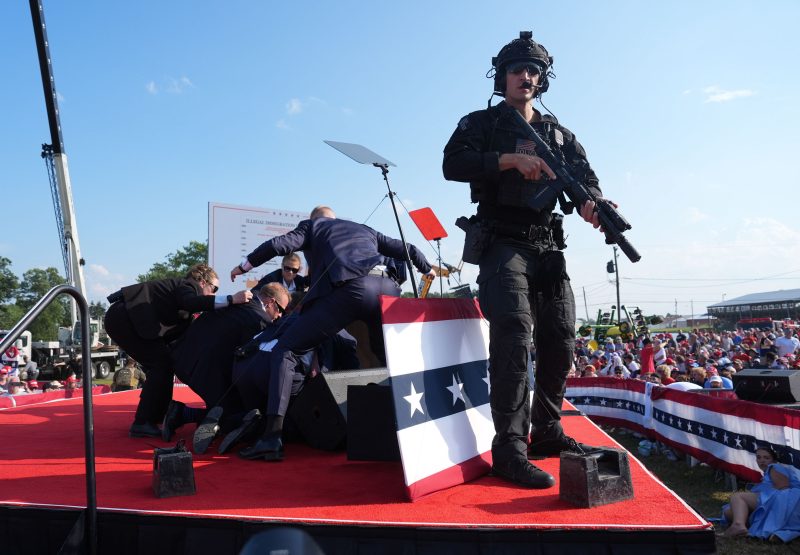Just before Donald Trump held a rally in Doral, Fla., on July 9, Secret Service officials delivered his campaign a message: The former president and his advisers would notice additional security because the U.S. government had credible intelligence of threats against him.
“The bad guys are at it again,” an adviser said, describing the Secret Service’s message.
Days later, a Pakistani national was arrested during an FBI sting after allegedly taking part in a murder-for-hire plot on behalf of Iran targeting a politician or government official on U.S. soil. Officials familiar with the investigation said this month that the alleged plot raised concerns about Trump’s safety and prompted a number of meetings among top Justice Department officials.
On July 13, Trump was grazed by a bullet at a campaign rally in Pennsylvania when a gunman fired shots from an unsecured roof about 150 yards away. It left Trump’s team shocked that the gunman — who had no known connection to Iran or any other foreign power — had such a clear shot at him from such a close distance, given they had been informed just days earlier that the Secret Service was on high alert.
The series of events in early July illustrates the extraordinary challenges facing the Secret Service as it attempts to protect Trump — a former president running for office again and one of the world’s most recognizable people. He not only holds large-scale campaign rallies — as he plans to do this week — but also routinely hangs out with scores of people at the Mar-a-Lago Club in Palm Beach, Fla., and his other resorts.
The difficulties have prompted numerous arguments over the past 3½ years between agency officials, Trump and his advisers. His aides grew increasingly angry as many of their requests for additional security were rebuffed by the Secret Service, according to eight people familiar with the events, who like others for this story spoke on the condition of anonymity to describe internal discussions. They were also enraged that his Secret Service detail and team were not told for 30 minutes as police officials searched for a reported suspicious person at the July 13 rally who turned out to be the gunman, Thomas Matthew Crooks.
Trump aides say they had sometimes been forced to cancel or reschedule events when aides felt the venues were not going to be sufficiently secure. They described repeatedly being denied pleas for more snipers, bomb-sniffing dogs, magnetometers and specialty teams to protect Trump, often because agency higher-ups said extra resources were not available. Trump and his campaign have a close relationship with his security detail.
Secret Service leaders have described the July 13 shooting as a failure, with former director Kimberly Cheatle resigning under pressure after she appeared to blame local police for not better securing the site and falsely claiming the agency never denied Trump detail requests for added security before the shooting. The assassination attempt has raised renewed questions about the Service’s competence that flared a decade ago. On July 13, the Service failed to tackle an obvious risk it has made a top priority since President John F. Kennedy was assassinated in 1963: keeping a gunman on high ground from having a clear shot at the top officials they protect.
The agency also dramatically stepped up its protection efforts after the shooting. In recent weeks, Trump advisers say the security level seems as heavy as when he was president. Counter-snipers and other specialty teams are with Trump at events, and the security footprint at Mar-a-Lago has grown exponentially, Trump advisers say, with snipers on roofs, equipment to block drones, cars being searched and roads, particularly Ocean Boulevard, frequently blocked.
“We live in a military encampment again,” this person said.
Trump has complained about the additional security measures at Mar-a-Lago in recent weeks, even as he tells others they are necessary, people who have spoken to him say. While the club is closed for the season, it will reopen in the fall.
Those who regularly attend rallies also say the service is being more aggressive at those events.
Trump’s team had stopped scheduling outdoor rallies in the wake of the shooting at the Secret Service’s recommendation until the agency could craft a new security plan for such events. The agency this week approved plans to use bulletproof glass to shield Trump at future outdoor events, a layer of security normally only provided to presidents and vice presidents when it is deemed necessary.
Trump had indicated he didn’t want to appear at outdoor rallies until he had the ballistic glass to protect him, advisers say. He also wants to return to Butler, where he was shot, before the election — and hold an outdoor rally. The measures are a notable change from the time before the shooting, when the Secret Service repeatedly raised concerns with Trump’s advisers about his clubs, where people who had not been properly screened often came too close to him. His daily golf outings have also caused concerns, because he lets the courses stay open to the public and is in an exposed environment for hours at a time.
For example, at Trump International Golf Club in West Palm Beach, Fla., Trump would often sit down in the dining room near all sorts of paying customers who had not been screened. Another person who had dinner at Mar-a-Lago in 2023 said he walked in and wasn’t screened by any security personnel as Trump wandered about.
“We were totally shocked we could just walk in the bar and sit down right next to him,” a person who played there in 2023 said. “We didn’t go through mags, we didn’t do anything. We just finished our round and walked right over and sat next to him in the clubhouse and had lunch. You could just walk over to his table. It was pretty surprising to all of us.”
Current and former officials also said the agency has never been asked to provide such a heavy layer of protection to a former president and that the levels provided even before the shooting went beyond Secret Service guidelines. Some agency officials have grown frustrated with requests from Trump’s team to schedule events that seem especially challenging to protect, two of the people said.
Anthony Guglielmi, a spokesman for the Secret Service, declined to comment on the warnings before the Doral event, the interactions that troubled agents at his social clubs or the tensions between Trump, his team and the Secret Service detail. A spokeswoman for Trump declined to comment.
‘Intrusion Detection Plan’
One early fight came in 2021 after Trump returned to Mar-a-Lago, when his Secret Service detail grew concerned about several threats, according to people familiar with the matter.
They wanted to harden the famously porous club, where members could bring in strangers, classified documents could be found and Trump often roamed around on the patio, talking with whoever was in earshot about whatever was on his mind.
Trump’s Secret Service detail put together an “Intrusion Detection Plan” they believed would make the club a safer place for Trump. But when they asked for the funds — several million dollars, according to people with knowledge of the request — they were mostly denied by the Secret Service. They received about 10 percent of what they requested, according to people familiar with the dispute.
“Over the years, the U.S. Secret Service has continuously invested in security enhancements at former president Trump’s residences, including those in Mar-a-Lago, Trump Tower, and Bedminster, New Jersey,” the agency said in a statement. “For operational security reasons, the Secret Service does not discuss the specific costs used to conduct our protective responsibilities.”
Earlier this month, acting director Ronald Rowe said the agency had spent about $4 million on protecting Mar-a-Lago in the years since Trump left office.
Agents have repeatedly talked with staff about the need to do more to limit Trump’s encounters at Mar-a-Lago with strangers. The club and residence have always posed particular risks for Trump and his advisers — including many risks created by Trump himself. He likes to sit in the middle of the club and greet guests, and has resisted efforts from staff to curb access to him, Stephanie Grisham, his former press secretary, said.
“They didn’t see it as their job to protect his club, but to protect him,” said a former official involved in Trump’s protection. “But it could be hard to separate the two.”
During the Trump presidency, former chief of staff John F. Kelly eventually required a senior staffer to be around Trump at all times because he was so concerned about who might encounter the president. Former aides frequently worried about foreign nationals at the club, four former administration officials said, and eyed particular guests who they believed brought them.
“There was a general concern that living in basically a hotel is not something the Secret Service ever had to deal with before,” said John Bolton, his former national security adviser. “It’s unnatural to what they have dealt with for presidents over the years.”
Bolton said that when Trump would go to his golf clubs, the courses would be open to members and their guests — just like if Trump wasn’t there. “When we were in Doonbeg and Turnberry, the clubs were totally open for business,” he said, describing a presidential trip to Trump courses in Ireland and Scotland, respectively.
Trump’s detail was concerned about the ability of a sniper to kill Trump when he golfed during his presidency, especially in his fairly consistent weekend trips to his club in Virginia in the late spring and summer. They raised concerns that if news photographers were able to take long-range photos of Trump on the course, a gunman would have the same ability to put Trump in their sights.
Secret Service officials were privately frustrated because they spent millions of dollars preparing to protect Trump Tower in New York after he became president, but then he rarely went there.
“It was a nightmare,” one senior Trump administration official said, because of all the surrounding buildings, the density of that part of Manhattan and traffic concerns. The Secret Service still has space in the building.
“You cannot imagine how much time and energy was spent to try and protect that place,” one person familiar with the agency’s work said.
‘A long reach and deep pockets’
Two Secret Service officials familiar with Trump’s security detail said the manual that guides what protection should be provided generally recommends far fewer assets for Trump than he actually receives. His motorcade, for example, includes many more vehicles than former president Barack Obama’s did after he left office.
But the officials acknowledge that the Secret Service manual is dated in terms of its assessment of what former presidents deserve, and doesn’t take into account Trump’s unusually high profile and pace of public events. Trump is also the first former president to run for reelection since Herbert Hoover in 1940.
Bill Gage, a former Secret Service agent who worked on presidential protection during the Obama and George W. Bush administrations, said some presidents and former presidents are unusually difficult to protect because of their insistence on being in the public eye on a frequent basis, as Trump does.
Over the course of recent history, the Secret Service faced some similar protection challenges with former president Bill Clinton, who regularly made last-minute changes to his schedule, insisted on jogging on the National Mall and held a large number of public appearances shortly after he left office. When Bush left the presidency, Gage said, leaders of his detail pressed the agency to give him additional protection beyond what the Secret Service normally provided a former president because of Islamist threats related to his administration’s launching of the wars in Afghanistan and Iraq.
For Trump, the Iranian threats have been a regular concern, officials said, driven in part by a regime determined to kill him, as shown by the sting announced earlier this month.
“Trump killed Soleimani, so the Iranian threat is something totally different to deal with,” Gage said. “You have a state-sponsored active threat. I don’t think the Service has really dealt with that at that scale before. And not only a state-sponsored active threat, you have state sponsored splinter groups like Hezbollah. They have a long reach and deep pockets.”
While most former presidents spend time giving private speeches, writing books, vacationing and largely staying away from the general public, Trump has extensive events that include thousands, if not tens of thousands, of members of the general public — often at far-flung locales. He often likes to make “off-the-record” stops at venues such as restaurants, gas stations or ice cream shops where he encounters surprised members of the public.
In early 2024, Trump’s team alerted the Secret Service that they would have a busy year of large rallies, and they needed more resources, according to people familiar with the call.
Trump’s team usually proposes a site for a rally — often an outdoor airport or fairgrounds area. Teams go in advance and scout the site to determine where the security perimeter should be, how many agents would be needed to protect the area, where entrances should be set up, where snipers will be and what potential challenges the site poses, according to people familiar with the process.
A site plan is organized by the local field office and any requests for security staff and other resources are approved by the top officials at agency headquarters. Agents from the Secret Service’s office in Pittsburgh were involved in formulating the Butler rally plan, and Trump’s security detail was briefed on it beforehand. Often, there are days, if not weeks, of discussions about security plans.
Gage said Trump’s politically amped-up rhetoric and the hyperbolic political environment increase the need for additional protection for Trump.
“This is an environment where people not figuratively but literally hate political leaders from the other parties,” Gage said. “Trump has alienated half the country. Not being political here but that’s the reality.”





























